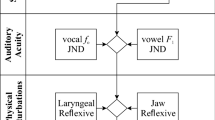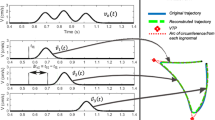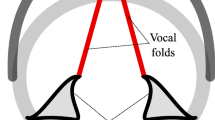Abstract
Different kinds of articulators, such as the upper and lower lips, jaw, and tongue, are precisely coordinated in speech production. Based on a perturbation study of the production of a fricative consonant using the upper and lower lips, it has been suggested that increasing the stiffness in the muscle linkage between the upper lip and jaw is beneficial for maintaining the constriction area between the lips (Gomi et al. 2002). This hypothesis is crucial for examining the mechanism of speech motor control, that is, whether mechanical impedance is controlled for the speech motor coordination. To test this hypothesis, in the current study we performed a dynamical simulation of lip compensatory movements based on a muscle linkage model and then evaluated the performance of compensatory movements. The temporal pattern of stiffness of muscle linkage was obtained from the electromyogram (EMG) of the orbicularis oris superior (OOS) muscle by using the temporal transformation (second-order dynamics with time delay) from EMG to stiffness, whose parameters were experimentally determined. The dynamical simulation using stiffness estimated from empirical EMG successfully reproduced the temporal profile of the upper lip compensatory articulations. Moreover, the estimated stiffness variation significantly contributed to reproduce a functional modulation of the compensatory response. This result supports the idea that the mechanical impedance highly contributes to organizing coordination among the lips and jaw. The motor command would be programmed not only to generate movement in each articulator but also to regulate mechanical impedance among articulators for robust coordination of speech motor control.
Similar content being viewed by others
References
Abbs JH, Folkins JW, Sivarajan M (1976) Motor impairment following blockade of the infraorbital: nerve implications for the use of anesthetization techniques in speech research. J Speech Hear Res 19(1):19–35
Abbs JH, Gracco VL, Cole KJ (1984) Control of multimovement coordination: sensorimotor mechanisms in speech motor programming. J Mot Behav 16(2):195–231
Agarwal GC, Gottlieb CL (1977) Compliance of the human ankle joint. Trans ASME 99:166–170
Akazawa K, Takizawa H, Hayashi Y, Fujii K (1988) Development of control system and myoelectric signal processor for bio-mimetic prosthetic hand. Biomechanism 9:43–53
Bennett DJ, Hollerbach JM, Xu Y, Hunter IW (1992) Time-varying stiffness of human elbow joint during cyclic voluntary movement. Exp Brain Res 88:433–442
Burdet E, Osu R, Franklin DW, Milner TE, Kawato M (2001) The central nervous system stabilizes unstable dynamics by learning optimal impedance. Nature 414:446–449
Cooker HS, Larson CR, Luschei ES (1980) Evidence that the human jaw stretch reflex increases the resistance of the mandible to small displacement. J Physiol 308:61–78
Folkins JW, Abbs JH (1975) Lip and jaw motor control during speech: responses to resistive loading of the jaw. J Speech Hear Res 18:207–220
Gomi H, Ito T, Murano EZ, Honda M (2002) Compensatory articulation during bilabial fricative production by regulating muscle stiffness. J Phon 30(3):261–279
Gomi H, Osu R (1996) Human arm stiffness and viscosity in interaction with environments on a horizontal plane. Technical Report ISRL-96-3, NTT Basic Research Laboratories, Information Science Research Laboratory, Kanagawa, Japan
Gomi H, Osu R (1998) Task-dependent viscoelasticity of human multijoint arm and its spatial characteristics for interaction with environments. J Neurosci 18(21):8965–8978
Gracco VL, Abbs JH (1985) Dynamic control of perioral system during speech: kinematic analysis of autogenic and nonautogenic sensorimotor processes. J Neurophysiol 54(2):418–432
Hain TC, Burnett TA, Larson CR, Kiran S (2001) Effects of delayed auditory feedback (daf) on the pitch-shift reflex. J Acoust Soc Am 109(5 Pt 1):2146–2152
Hogan N (1984) Adaptive control of mechanical impedance by coactivation of antagonist muscles. IEEE Trans Auto Cont AC-29(8):681–690
Houde JF, Jordan MI (1998) Sensorimotor adaptation in speech production. Science 279(5354):1213–1216
Ito T, Gomi H, Honda M (2000) Task dependent jaw-lip coordination examined by jaw perturbation during bilabial-consonant utterances. In: Proceedings of the 5th seminar on speech production (SPS5), 1–4 May 2000, Kloster Seeon, Bavaria, Germany, pp 41–44
Ito T, Gomi H, Honda M (2003) Articulatory coordination using mechanical linkage between upper lip and jaw examined by jaw perturbation. Trans IEICE J86-DII(2):333–341
Kearney RE, Hunter IW (1982) Dynamics of human ankle stiffness: variation with displacement amplitude. J Biomech 15(10):753–756
Kearney RE, Hunter IW (1990) System identification of human joint dynamics. Crit Rev Biomed Eng 18:55–87
Kelso JAS, Tuller B, Vatikiotis-Bateson E, Fowler CA (1984) Functionally specific articulatory cooperation following jaw perturbations during speech: evidence for coordinative structures. J Exp Psychol Hum Percept Perform 10(6):812–832
Kelso JAS, Vatikiotis-Bateson E, Saltzman EL, Kay B (1985) A qualitative dynamics analysis of reiterant speech production: phase portraits, kinematics, and dynamic modeling. J Acoust Soc Am 77(1):266–280
Koike Y, Kawato M (1995) Estimation of dynamic joint torque and trajectory formation from surface electromyography signals using a neural network model. Biol Cybern 73:291–300
Lacquaniti F, Carrozzo M, Borghese NA (1993) Time-varying mechanical behavior of multijointed arm in man. J Neurophysiol 69(5):1443–1464
Mannard A, Stein RB (1973) Determination of the frequency response of isometric soleus muscle in the cat using random nerve stimulation. J Physiol 229(2):275–296
Meek SG, Wood JE, Jacobsen SC (1990) Model-based, multi-muscle EMG control of upper-extremity prostheses. In: Winters JM, Woo S-Y (eds) Multiple muscle systems. Springer, Berlin Heidelberg New York, pp 360–376
Mussa-Ivaldi FA, Hogan N, Bizzi E (1985) Neural, mechanical, and geometric factors subserving arm posture in humans. J Neurosci 5(10):2732–2743
Osu R, Franklin DW, Kato H, Gomi H, Domen K, Yoshioka T, Kawato M (2001) Short-and long-term changes in joint co-contraction associated with motor learning as revealed from surface EMG . J Neurophysiol 88(2):991–1004
Osu R, Gomi H (1999) Multijoint muscle regulation mechanisms examined by measured human arm stiffness and EMG signals. J Neurophysiol 81(4):1458–1468
Saltzman E (1986) Task dynamic coordination of the speech articulators: a preliminary model. Experimental Brain Research Series, vol 15. Springer, Berlin Heidelberg New York
Shaiman S (1989) Kinematic and electromyographic responses to perturbation of the jaw. J Acoust Soc Am 86(1):78–88
Stevens KN (1998) Acoustic phonetics. MIT Press, Cambridge, MA
Tremblay S, Shiller D, Ostry D (2003) Somatosensory basis of speech production. Nature 423:866–869
Author information
Authors and Affiliations
Corresponding author
Additional information
Acknowledgements This research was supported by Core Research for Evaluation Science and Technology (CREST) of the Japan Science and Technology Agency. We thank J. Perkell (Massachusetts Institute of Technology) for giving us a number of helpful suggestions and improving the manuscript. We also thank T. Hirahara (ATR Human Information Science Laboratories) for his continuing encouragement, E.Z. Murano (ATR Human Information Science Laboratories) for her assistance in the experiment, and T. Konno and M. Sawada (NTT-AT) for their support in software development.
Rights and permissions
About this article
Cite this article
Ito, T., Gomi, H. & Honda, M. Dynamical simulation of speech cooperative articulation by muscle linkages. Biol. Cybern. 91, 275–282 (2004). https://doi.org/10.1007/s00422-004-0510-6
Received:
Accepted:
Published:
Issue Date:
DOI: https://doi.org/10.1007/s00422-004-0510-6




